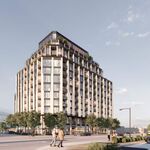Second_in_pie
Senior Member
Okay fine, forget that.I don't think anyone has raised the possibility of anything other than a tunnel along Eglinton between at least Keele and Laird.
My second
Okay fine, forget that.I don't think anyone has raised the possibility of anything other than a tunnel along Eglinton between at least Keele and Laird.
Something interesting I saw in plans somewhere is to investigate uses of the Finch Hydro Corridor, and I think that above ground Rapid Transit like the Canada Line could be used very well there, as well as on an extended SRT. I just wonder why they plan on investigating the Hydro Corridor almost right after they build the Finch West LRT, when they could be providing better service at almost the same price on the undeveloped land.
I'm thinking we should pick a corridor to actually facilitate fast crosstown travel, meaning stations spaced 2 - 4 km+ apart.
So.... GO midtown?
Indeed. Stop calling it Go Midtown and start calling it TTC midtown, with service and fares accordingly.
For the Bloor/Danforth subway, what is the percentage of passengers who ride this system through the downtown core, from east to west or vise-versa? If it is just a small percentage maybe they should consisder dividing the Eglinton route into two seperate routes an eastern portion from Yonge to Kennedy and a western portion from Yonge to the airport or Mississauga. This type of set up might service the majority of riders if that is where most of the ridership is going anyway.
I'm thinking we should pick a corridor to actually facilitate fast crosstown travel, meaning stations spaced 2 - 4 km+ apart.
This was my largest disappointment with the final Metrolinx RTP. The 401 REX line would have been hugely valuable for cross-region travel. Granted, it would have been hugely expensive...If we want good cross-town service Afransen is absolutely right. We need GO style service.
One area that should be studied is the #'s 34 and 32 bus routes. I don't ride the 32 but I have ridden the 34 quite a bit. Most of the riders get off this bus and head for the subway platform. I haven't noticed many of my fellow riders leave the 34 bus and head for the 32 bus. If the present day existing ridership is using this route to get to downtown, where most of our work lies, it would make sense to split the Eglinton cross town route in two. Sure it would incovenience a small percentage of riders who aren't going downtown but it will service the majority of us riders well.




